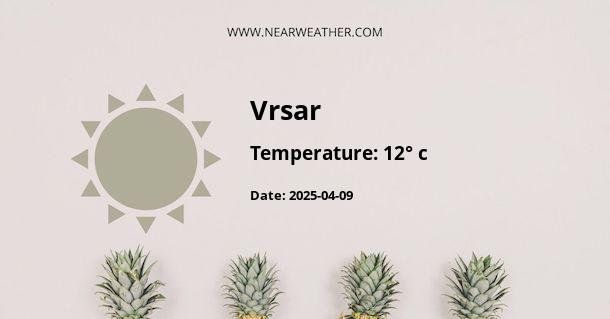Climate and Weather of Vrsar, Croatia
The picturesque town of Vrsar (Orsera in Italian), located on the western coast of the Istrian peninsula in Croatia, offers visitors a unique climate influenced by the Adriatic Sea. With its Mediterranean climate, Vrsar enjoys mild, wet winters and warm, dry summers, making it an attractive destination for tourists year-round. Let's delve deeper into the climatic conditions and weather patterns that characterize Vrsar throughout the seasons.
General Climate Overview
Vrsar experiences a temperate climate with a strong Mediterranean influence. Winters are mild with some precipitation, while summers are warm and relatively dry. The area is subject to the maestral wind - a cooling sea breeze that provides relief during the hotter months.
Seasonal Weather Patterns
In this region, the climate is categorized under the Köppen climate classification as Csa, which signifies a Mediterranean climate with hot summers.
Spring in Vrsar
- Temperature: The spring season sees a gradual increase in warmth, starting from an average of 9°C (48°F) in March to around 21°C (70°F) by the end of May.
- Precipitation: Rainfall tends to decrease as the season progresses, with an average accumulated amount decreasing from month to month.
- Weather Events: Occasional thunderstorms may occur, typically short-lived, often clearing up quickly to reveal sunny skies.
Summer in Vrsar
- Temperature: Summer temperatures average around 22°C to 30°C (72°F to 86°F), with heatwaves potentially pushing temperatures higher.
- Precipitation: The summer months are the driest of the year, with July often being the driest month. Rain usually comes in the form of short, heavy downpours or thunderstorms.
- Weather Events: Summertime is generally stable and predictable, with a low likelihood of severe weather.
Autumn in Vrsar
- Temperature: Autumn brings a cool down with averages ranging from 10°C (50°F) to 21°C (70°F) across the season.
- Precipitation: September can still be relatively dry, but rainfall increases through October and November, with November being one of the wetter months.
- Weather Events: The autumn can see the return of occasional thunderstorms and increased windiness.
Winter in Vrsar
- Temperature: Winter temperatures hover between 2°C (36°F) and 10°C (50°F), rarely reaching freezing due to the moderating influence of the sea.
- Precipitation: Winters are the wettest time of year for Vrsar, with December and January typically seeing the most precipitation.
- Weather Events: Although snow is rare, winter storms and strong winds can occur, with the bura wind bringing cold, dry air from the continent.
Year-round Weather Averages and Extremes
The following data provides an indication of the typical temperature ranges and precipitation levels in Vrsar:
| Month | Average High | Average Low | Precipitation |
|---|---|---|---|
| January | 9°C (48°F) | 3°C (37°F) | 78 mm (3 in) |
| February | 10°C (50°F) | 3°C (37°F) | 67 mm (2.6 in) |
| March | 13°C (55°F) | 6°C (43°F) | 65 mm (2.6 in) |
| April | 17°C (63°F) | 9°C (48°F) | 74 mm (2.9 in) |
| May | 21°C (70°F) | 13°C (55°F) | 63 mm (2.5 in) |
| June | 25°C (77°F) | 16°C (61°F) | 57 mm (2.2 in) |
| July | 28°C (82°F) | 18°C (64°F) | 35 mm (1.4 in) |
| August | 28°C (82°F) | 18°C (64°F) | 66 mm (2.6 in) |
| September | 24°C (75°F) | 15°C (59°F) | 85 mm (3.3 in) |
| October | 19°C (66°F) | 12°C (54°F) | 85 mm (3.3 in) |
| November | 14°C (57°F) | 8°C (46°F) | 108 mm (4.2 in) |
| December | 10°C (50°F) | 4°C (39°F) | 120 mm (4.7 in) |
Please note that these figures are averages and actual conditions can vary. Vrsar, like many other places, has experienced its share of weather extremes, with temperature records, both highs and lows, as well as significant storm events.
Impact of Climate on Tourism and Activities
The climate and weather in Vrsar greatly influence the activities and tourism in the area. The warm and dry summers make it an ideal destination for beach activities, sailing, and exploring the local archipelago of 18 unspoiled islands. Meanwhile, the mild winters allow for comfortable exploration of historical sites and enjoying the outdoors without the intense heat of summer.
- In the summer, the predictable warm weather promotes a bustling atmosphere with numerous festivals, outdoor dining, and water-based activities.
- Spring and autumn are particularly pleasant for cycling and hiking as the temperatures are moderate, and the natural surroundings are vibrant.
- Winter, while cooler, still allows for exploration of cultural landmarks and enjoying local cuisine, albeit with more indoor focus due to increased rainfall.
Long-term Weather and Climate Challenges
Climate change poses challenges to the Vrsar region, as it does to many parts of the world. Rising sea levels and increased frequency of extreme weather events could impact the coastal town's economy, infrastructure, and natural ecosystems. Adaptation and mitigation strategies are necessary to preserve the town's rich cultural heritage and vibrant tourism industry.
Proactive efforts are required, such as sustainable tourism practices, preserving natural habitats, and investing in infrastructure that can withstand extreme weather conditions.
Conclusion
In conclusion, Vrsar's climate plays a central role in shaping the lifestyle and activities available in this beautiful Croatian town. With its pleasant Mediterranean climate, Vrsar offers visitors and residents enjoyable weather conditions for the majority of the year. Attention to sustainable practices and climate change adaptation will be essential in ensuring that Vrsar remains a beloved destination for generations to come.
A - Vrsar's Latitude is 45.149170 & Longitude is 13.605280.
A - Weather in Vrsar is 12° today.
A - Climate Conditions in Vrsar shows overcast clouds today.
A - Humidity in Vrsar is 67% today.
A - Wind speed in Vrsar is 12.64 km/h, flowing at 132° wind direction. today.
